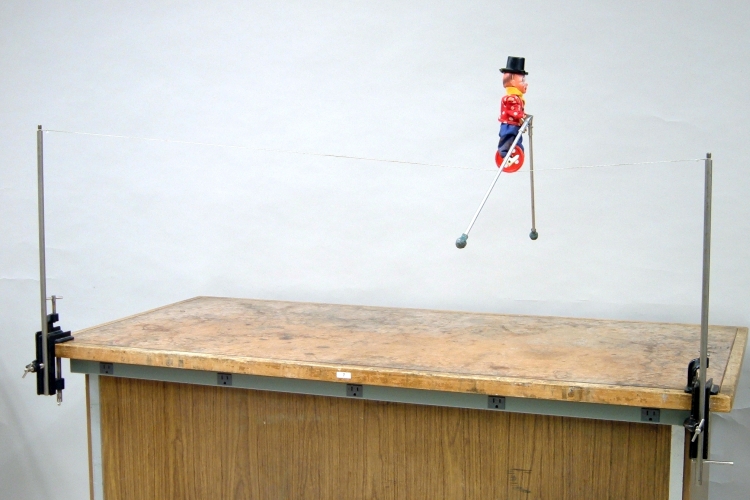
A video of this demonstration is available at this link.
A toy clown sitting on a unicycle, holds an inverted-V-shaped rod at whose ends are lead masses. These masses are great enough to bring the center of mass of the clown on his unicycle to a point somewhere below the tightrope. To displace the center of mass from this point, you must apply a torque about the point where the wheel sits on the tightrope, which gravity opposes by exerting a torque at the center of mass, about the same point. The clown can thus ride the tightrope without fear of falling off it.
The center of mass of an object is the weighted mean displacement of all of its mass points from some reference point, usually the origin of the coordinate system in which the object sits. This is the sum of the products of all the mass points with their distances from the origin, divided by the total mass of the object (rcm = Σmiri/M). If we set the center of mass of the object at the origin, we find that this sum equals zero. This tells us that if we exert a force on the object at its center of mass, this results in no torque on the object, but if we apply a force to the object at any other point, we exert a torque on the object about its center of mass.
If the object is relatively small, and close to the earth, then gravity acts uniformly on the object. That is, if the object is of uniform density, gravity exerts the same downward force on all of its mass points, and the sum of all of these forces is equal to a single downward force, F = Mg, acting at the center of mass of the object. The torque due to each of these forces, about the center of mass of the object, is τ = miri × g, and the sum of the torques is τ = (Σmiri) × g. If we set the center of mass of the object at the origin, this sum equals zero. Thus if we apply a force at the center of mass, that is equal to and opposite that of gravity, we can support the object without exerting a torque on it about its center of mass. This point at which the resultant force of gravity acts is also called the center of gravity. If we take the force of gravity as being uniform over the entire object, then the center of gravity and the center of mass are the same point.
If we suspend an object from any point other than the center of mass, then, we exert a torque on the object about its center of mass. Gravity, in turn, acting at the object’s center of mass, exerts an equal and opposite torque about the suspension point. Thus, if we suspend an object this way, the center of mass must lie on a vertical line below the suspension point. For the clown on the tightrope, the masses at the ends of the V-shaped rod are great enough to bring the center of mass of the clown-unicycle-bar system to a point somewhere below the tightrope. When we place the clown on his unicycle on the tightrope, we are thus suspending the system from the bottom of the wheel of the unicycle. The torque we exert about the center of mass by doing this is balanced by an opposing torque by gravity about this suspension point, acting at the center of mass of the clown on his unicycle. Thus, the clown can ride down the tightrope on his unicycle without fear of falling off it.
References:
1) Resnick, Robert and Halliday, David. Physics, Part One, Third Edition (New York: John Wiley and Sons, 1977), pp. 162-5, 283-5.